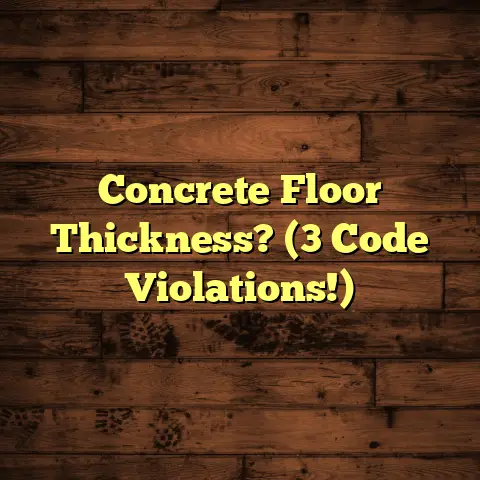Hardwood For Large Spaces? (3000 Sq Ft Pro Guide)
Have you ever walked into a grand, open space and been immediately struck by the warmth and elegance of the hardwood flooring? I have, countless times.
It’s amazing how the right flooring can transform a sprawling 3000 sq ft area into a truly inviting environment.
Choosing the right flooring for a large space can feel daunting. I get it.
It’s an investment, and you want to make the right choice. That’s why I’ve put together this guide.
I’ll walk you through everything you need to know about selecting and installing hardwood flooring in large spaces.
We’ll cover everything from understanding different wood species and installation methods to maintenance tips and real-life examples.
So, grab a coffee, settle in, and let’s get started!
Here’s what we’ll be diving into:
- Understanding Hardwood Flooring
- Evaluating Your Large Space
- Choosing the Right Hardwood Flooring
- Installation Process for Large Spaces
- Maintenance and Care for Hardwood in Large Areas
- Real-Life Examples and Case Studies
Section 1: Understanding Hardwood Flooring
Let’s start with the basics. What exactly is hardwood flooring?
Simply put, it’s flooring made from a single piece of wood, typically from deciduous trees like oak, maple, or cherry.
However, there are actually two main types: solid and engineered.
Solid Hardwood: This is the classic choice – planks milled from a single piece of wood. It can be refinished multiple times, making it a long-lasting option.
Engineered Hardwood: This consists of a thin layer of hardwood veneer bonded to a core of plywood or high-density fiberboard.
It’s more dimensionally stable than solid hardwood, meaning it’s less prone to warping or cupping in areas with high moisture.
Different Wood Species
Now, let’s talk wood species. Each has its own unique characteristics:
- Oak: The most popular choice, known for its durability and distinctive grain pattern. Red oak and white oak are the two main varieties.
- Maple: A lighter-colored wood with a fine, uniform grain. It’s very hard and resistant to dents and scratches.
- Cherry: A beautiful reddish-brown wood that darkens with age. It’s softer than oak or maple, so it may not be the best choice for high-traffic areas.
- Hickory: One of the hardest and most durable domestic hardwoods. It has a rustic look with a lot of character.
- Walnut: A rich, dark brown wood with a beautiful grain. It’s a softer hardwood, so it’s more prone to scratches and dents.
Benefits of Hardwood in Large Spaces
Why choose hardwood for a large space? Here are a few reasons:
- Aesthetics: Hardwood adds warmth, elegance, and a timeless appeal to any room.
- Durability: With proper care, hardwood flooring can last for decades.
- Value: Hardwood flooring can increase the value of your home.
- Versatility: It complements a wide range of design styles, from traditional to modern.
- Cleanliness: Hardwood is easy to clean and maintain, making it a great choice for families with kids or pets.
Common Misconceptions
Let’s bust some common myths about hardwood:
-
Myth: Hardwood is too expensive.
- Reality: While it can be an investment, there are hardwood options to fit a variety of budgets. Plus, the longevity and added home value make it worthwhile.
-
Myth: Hardwood is difficult to maintain.
- Reality: With regular sweeping and occasional mopping, hardwood is relatively easy to care for.
-
Myth: Hardwood is not suitable for homes with pets.
- Reality: Choose a harder wood species and apply a durable finish, and your hardwood floors can withstand the wear and tear of pets.
-
Myth: Hardwood installation is a DIY-friendly project.
- Reality: While some experienced DIYers can tackle hardwood installation, it’s often best left to the professionals, especially in large spaces where precision and expertise are crucial.
Section 2: Evaluating Your Large Space
Before you even start looking at wood samples, it’s essential to take a good, hard look at your space.
I’m talking about really understanding its unique characteristics. A 3000 sq ft area isn’t just one big room; it’s likely a combination of different zones, each with its own purpose and traffic patterns.
Assessing Your Space
Here are some key factors to consider:
- Layout: Is it an open floor plan or a series of smaller rooms? This will influence the flow of the flooring and how it visually connects the spaces.
- Lighting: Natural light can dramatically affect the appearance of hardwood. Darker woods can make a room feel cozier, while lighter woods can brighten up a space.
- Existing Decor: Consider the style and color palette of your furniture, walls, and other design elements. You want your hardwood flooring to complement your existing decor.
- Functionality: How will the space be used? A living room will have different traffic patterns than a kitchen or a bedroom.
- Traffic Patterns: Identify the high-traffic areas, such as hallways and entryways. These areas will require a more durable hardwood and a stronger finish.
Measuring the Area
Accurate measurements are crucial. I always recommend measuring the length and width of each room and then multiplying those numbers to get the square footage.
Add up the square footage of all the rooms to get the total area you need to cover.
Don’t forget to add extra for waste (typically 5-10%).
Subfloor Conditions
The subfloor is the foundation upon which your hardwood flooring will be installed. It’s essential to ensure that it’s level, clean, and dry.
- Levelness: Use a level to check for any dips or humps in the subfloor. Unevenness can cause problems with the installation and can lead to squeaks and creaks later on.
- Cleanliness: Sweep or vacuum the subfloor thoroughly to remove any debris.
- Dryness: Moisture is the enemy of hardwood. Use a moisture meter to check the moisture content of the subfloor. It should be within the acceptable range for the type of hardwood you’re installing.
How These Factors Influence Your Choice
All of these factors will influence your hardwood flooring choice.
For example, if you have a lot of natural light, you might be able to get away with a darker wood.
If you have a high-traffic area, you’ll want to choose a durable wood species with a strong finish.
And if your subfloor is uneven, you may need to consider a floating installation method.
Section 3: Choosing the Right Hardwood Flooring
Now for the fun part: picking out your hardwood! With so many options available, it can feel overwhelming.
I’ll break down the key considerations to help you make the right choice for your large space.
Comparing Hardwood Options
Let’s delve deeper into the different aspects:
-
Grain Patterns:
- Plain Sawn: This is the most common cut, producing a cathedral-like grain pattern. It’s less expensive but more prone to cupping.
- Quarter Sawn: This cut produces a straighter grain pattern and is more dimensionally stable. It’s more expensive than plain sawn.
- Rift Sawn: This cut is similar to quarter sawn but produces an even straighter grain pattern. It’s the most expensive cut.
-
Color:
- Light Woods: Maple, ash, and birch can brighten up a space.
- Medium Woods: Oak, cherry, and hickory offer a balance of warmth and elegance.
- Dark Woods: Walnut, mahogany, and ebony add drama and sophistication.
-
Finish:
- Polyurethane: The most common finish, known for its durability and water resistance.
- Oil-Based: Provides a warm, natural look but requires more maintenance.
- Water-Based: A more eco-friendly option that’s low in VOCs.
-
Thickness:
- Solid Hardwood: Typically 3/4 inch thick, allowing for multiple refinishings.
- Engineered Hardwood: Varies in thickness, but the thicker the veneer layer, the more durable it will be.
Installation Methods
Choosing the right installation method is crucial, especially in large spaces. Here’s a breakdown:
- Nail-Down: This method is typically used for solid hardwood. The planks are nailed directly to the subfloor. It’s a secure and long-lasting installation, but it requires a wood subfloor.
- Glue-Down: This method is used for both solid and engineered hardwood. The planks are glued directly to the subfloor. It provides a very stable and quiet installation, but it can be messy and difficult to remove.
- Floating: This method is typically used for engineered hardwood. The planks are connected to each other but not to the subfloor. It’s a faster and easier installation method, but it can feel less solid underfoot.
Eco-Friendly Options and Sustainable Practices
If you’re concerned about the environment, look for hardwood flooring that is certified by the Forest Stewardship Council (FSC).
This certification ensures that the wood comes from responsibly managed forests.
You can also consider reclaimed hardwood, which is wood that has been salvaged from old buildings or structures.
Complementing Your Design Theme
When choosing your hardwood, think about the overall design theme of your space.
- Traditional: Choose a classic wood like oak or cherry with a warm finish.
- Modern: Opt for a sleek and minimalist wood like maple or ash with a light finish.
- Rustic: Go for a wood with a lot of character, like hickory or reclaimed wood, with a distressed finish.
Section 4: Installation Process for Large Spaces
Okay, you’ve chosen your dream hardwood. Now it’s time to get it installed!
Installing hardwood in a 3000 sq ft area is a significant undertaking.
I always advise homeowners to carefully consider whether they want to tackle it themselves or hire professionals.
Preparation Steps
Proper preparation is key to a successful installation:
- Acclimation: Allow the hardwood flooring to acclimate to the environment for several days before installation. This will help prevent warping or cupping.
- Moisture Testing: Use a moisture meter to check the moisture content of both the hardwood and the subfloor. They should be within the acceptable range.
- Subfloor Preparation: Ensure that the subfloor is level, clean, and dry. Make any necessary repairs or leveling adjustments.
Elaborating on Installation Methods
Let’s revisit the installation methods in the context of large spaces:
- Nail-Down: Ideal for solid hardwood and provides a secure, long-lasting installation. However, it requires a wood subfloor and can be time-consuming in large areas.
- Glue-Down: Offers excellent stability and sound reduction, but can be messy and challenging to remove. It’s suitable for both solid and engineered hardwood.
- Floating: A faster and easier option for engineered hardwood, especially in large spaces. However, it may not feel as solid underfoot as other methods.
Hiring Professionals vs. DIY
While some experienced DIYers can tackle hardwood installation, it’s often best to hire professionals, especially in large spaces.
Professionals have the tools, expertise, and experience to ensure a flawless installation.
They can also handle any unexpected challenges that may arise.
Potential Challenges
Here are some common challenges you might encounter:
- Uneven Subfloor: This can cause problems with the installation and can lead to squeaks and creaks later on.
- Moisture Issues: Moisture can cause hardwood to warp, cup, or buckle.
- Matching Grain Patterns: It can be difficult to match grain patterns across a large area.
- Cutting Around Obstacles: Cutting around doorways, pipes, and other obstacles can be tricky.
Section 5: Maintenance and Care for Hardwood in Large Areas
Congratulations, your hardwood flooring is installed! Now it’s time to keep it looking its best.
Maintaining hardwood in a large, high-traffic area requires a bit of effort, but it’s well worth it to protect your investment.
Cleaning Techniques
- Regular Sweeping or Vacuuming: This is the most important step in maintaining hardwood floors. Sweep or vacuum at least once a week to remove dirt, dust, and debris.
- Damp Mopping: Mop your floors with a damp mop and a hardwood floor cleaner. Be sure to wring out the mop thoroughly to avoid getting too much water on the floors.
- Avoid Harsh Chemicals: Never use harsh chemicals, abrasive cleaners, or scouring pads on your hardwood floors.
Recommended Products
- Hardwood Floor Cleaner: Use a cleaner that is specifically designed for hardwood floors.
- Microfiber Mop: A microfiber mop is gentle on hardwood floors and effectively removes dirt and dust.
- Doormats: Place doormats at all entrances to trap dirt and debris.
- Area Rugs: Use area rugs in high-traffic areas to protect the floors from wear and tear.
Common Issues and Mitigation
- Warping: This can be caused by moisture. Ensure that your home has proper ventilation and avoid excessive moisture.
- Scratching: This can be caused by pets, furniture, or shoes. Use furniture pads and trim your pets’ nails.
- Fading: This can be caused by sunlight. Use curtains or blinds to protect your floors from direct sunlight.
Refinishing
Over time, even with the best care, hardwood floors can start to look worn and faded.
Refinishing can restore the beauty of your floors and extend their lifespan.
The frequency of refinishing depends on the amount of traffic and wear and tear the floors receive.
Typically, hardwood floors can be refinished every 10-15 years.
Section 6: Real-Life Examples and Case Studies
Let’s take a look at some real-life examples of large spaces that have been transformed with hardwood flooring.
Case Study 1: The Open-Concept Living Area
- Challenge: A 3200 sq ft open-concept living area needed flooring that would define the different zones while maintaining a cohesive look.
- Solution: Wide-plank engineered hardwood with a wire-brushed finish was chosen. The wide planks created a sense of spaciousness, while the wire-brushed finish added texture and character.
- Result: The hardwood flooring beautifully connected the living room, dining room, and kitchen, creating a warm and inviting space for entertaining and family gatherings.
Case Study 2: The Modern Loft
- Challenge: A 2800 sq ft loft with concrete floors needed flooring that would add warmth and soften the industrial aesthetic.
- Solution: Bamboo flooring was selected for its sustainability and modern look. The light color of the bamboo brightened up the space, while the clean lines complemented the industrial design.
- Result: The bamboo flooring transformed the loft into a stylish and comfortable living space.
Case Study 3: The Historic Home
- Challenge: A 3500 sq ft historic home needed flooring that would be consistent with its original character and charm.
- Solution: Reclaimed hardwood flooring was chosen for its authenticity and unique character. The reclaimed wood added warmth and history to the home.
- Result: The reclaimed hardwood flooring preserved the historic integrity of the home while adding a touch of elegance.
Conclusion
Choosing the right hardwood flooring for a large space can be a complex decision.
But by understanding the different types of hardwood, evaluating your space, and considering your design preferences, you can create a stunning and functional space that you’ll enjoy for years to come.
Remember, the right hardwood flooring can dramatically elevate the aesthetic and functionality of your home.
So, what are you waiting for? Start planning your hardwood flooring transformation today!





